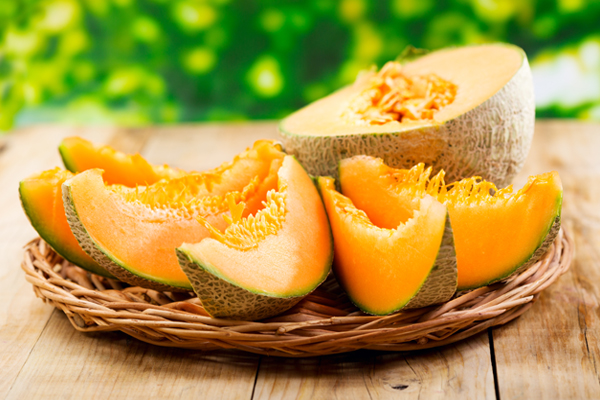The melon, sweet, refreshing and very complete
The melon is one of the most commonly-eaten fruits during the summer. Consisting mostly of water, it is one of the top fruits to consume on hot days.
fresh food
Share

Although we are not completely sure where the melon originates from, its history shows that it is one of the first fruits cultivated by humans. In fact, many studies document the great development this fruit had during Egyptian, Greek and Roman times. Experts place its origins in Central Asia, although its production has ultimately spread throughout the Mediterranean and America.
Today, it is mainly grown in China, Japan, The United States, France and Spain (Almería, Badajoz, Cádiz, Ciudad Real, Córdoba, Huelva, Murcia, Sevilla, Toledo and Valencia).
The melon is grown in countries with a warm climate and has its origin in the Cucurbitaceae family, to which the pumpkin, cucumber and watermelon also belong.
The fruit has a round or oval shape, with hard and somewhat coarse skin. Its colour varies between yellow and a deep green on the outside, and is an intense yellow on the inside. The pulp has a soft, sweet flavour and is accompanied by seeds or pips which are easy to remove.
The most popular and most consumed varieties
Today there are more than a hundred varieties, classified according to their shape, their pulp and skin colour, ripening period, etc. Although we can find melons at any time of the year, the best quality ones are grown between the months of June and September.
Entre las principales variedades encontramos:
- Cantalupo or “French melon”: with a round shape, this melon is well-appreciated for its flavour and aroma. Its skin has a clear green colour with very characteristic webbed markings.
- Galia: this is a round melon, with fine skin and soft pulp. Its colour is green (on the outside) and yellowish (on the inside). It has a sweet flavour and is very aromatic.
- Honey dew: This variety had a longish shape and a smooth, clear green coloured skin. Its pulp is juicy and light yellow in colour. This fruit is a late ripener.
- Ogen or “Canary Island melon”: this is one of the first melons of the season. It is small and round, with a fine, yellow-coloured skin and with clear green pulp. It has a sweet taste and is very juicy.
- Piel de sapo: also known as the “piñonet” variety, this is an oval-shaped melon, with a slightly-rough, deep-green skin and a white, smooth and very sweet pulp.
- Tendral: known as “winter melon”, this variety is produced mainly during the colder months of the year (from November to January). It has an oval shape with thick, rough skin and white pulp which contains a considerable amount of sugar.

Nutritional benefits
The melon is a complete food which helps us to refresh ourselves during hot days. It is one of the most appreciated foods, particularly because of its large water content (90-95% of its weight) and the few calories it contains.
It also stands out because of its carbohydrate content (6%), its low fat and its low protein values. As a result of which it contains very few calories.
Eat melon as often as you can. 100 grams provide you with over half of the daily recommended Vitamin C.
Eat melon as often as you can. 100 grams provide you with over half of the daily recommended Vitamin C.

Advice for buying and storing
To find out if a melon is ripe, press the ends to see if they feel a little soft under pressure and, when you pick it up, it should not feel hollow.
When shopping, choose melons that feel firm and do not have any marks on them.
To store, keep them in a cool, dry place.
Once you have cut them open, you should eat them quickly so they don’t lose their flavour and properties. If kept in the fridge, store them in the least cold part, as they are sensitive to low temperatures. We recommend you don’t store them below 7-10 ºC.
Using melon in the kitchen
AAlthough melon is mostly eaten raw after a meal, its versatility allows you to also use it as a starter, or to accompany a salad and some types of soup. Who hasn’t tried melon and serrano ham at some time?
It is a product that perfectly combines with other sweet fruit, dry fruits, honey, and even some alcoholic drinks, such as sherry or port.
Apart from eating it raw, as a dessert, it can be presented as an ice cream, slushy and sorbet to refresh you on the hottest of days.






